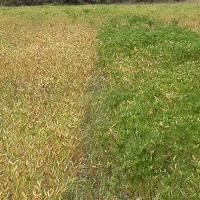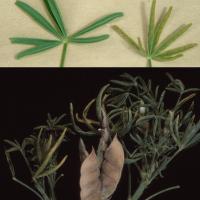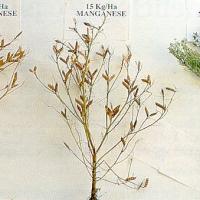Diagnosing manganese deficiency in narrow-leafed lupins
Manganese deficiency usually has little effect on vegetative growth but can substantially reduce grain yield ('split seed').
What to look for
- Lower yielding plants that stay green longer, and have straggly growth.
- Affected plants are more common in deep sandy parts of the paddock.
Paddock
- Plants stay green with straggly new growth as leaves drop and pods fill on unaffected plants.
- Seeds split through the seed coat and sometimes discolour around the margins.
- The seed may also be small, shrivelled and poorly developed.
- Young leaf leaflets develop a chlorotic margin with a dirty brown patchiness, but remain green near the base.
- Rarely, leaflets on severely deficient plants become claw shaped with purplish tips and margins.
Plant
Where does it occur?

Soil type

Dry conditions
- Split seed occurs mainly in slightly acidic grey sand, yellow sands and deeper gravelly sands commonly in the south and west, where the average annual rainfall is more than 450 mm.
- Split seed disorder also occurs in patches of the low rainfall wheatbelt in some seasons,usually on coarser, deeper, more leached sands.
- Narrow-leafed lupin has a poor ability to accumulate manganese in its grain.
- Lupins are able to access manganese that is unavailable to cereals on high P-fixing soils, but are more deficient on very low manganese content sandy soils.
- Manganese is very immobile in plants and needs to be taken up from soil as the grain fills and matures.
- Sandy soils rapidly dry between rain events in spring. Deficiency is worse in dry seasons, particularly with a dry spring.
- Deficiency is frequently worse on late sown crops.
- Heavy liming may cause temporary manganese deficiency.
Management strategies

Spraying foliar

Soil application
- A foliar spray at pod size 2-3cm on the main stem can prevent split seed but has almost no residual value.
- 25 to 30kg manganese sulphate drilled at seeding is effective on west Midlands yellow sands and south coast sands. Two applications will provide protection for at least 13-15 years.
- 15 to 20kg manganese sulphate drilled before seeding is effective on west Midlands white sands and sandy gravels.Two applications will provide protection for about 13 years.
- Manganese is immobile in the soil. Compared to drilled fertiliser, topdressed manganese is between 25%- 50% less effective, and deep placed manganese up to twice as effective in dry spring weather.
How can it be monitored?

Tissue test
- The lupin stem test is very accurate but depends very much on timing. Take the stem from ground level to the flower at mid-flowering, strip all the leaves and laterals off, and send for analysis. Samples with Mn concentration less than 20 mg/kg require a Mn spray.
- Whole plant, leaf tests, and soil tests, are not reliable enough to detect deficiency.
See also
Further information
Where to go for expert help
Page last updated: Friday, 19 July 2019 - 8:24am





